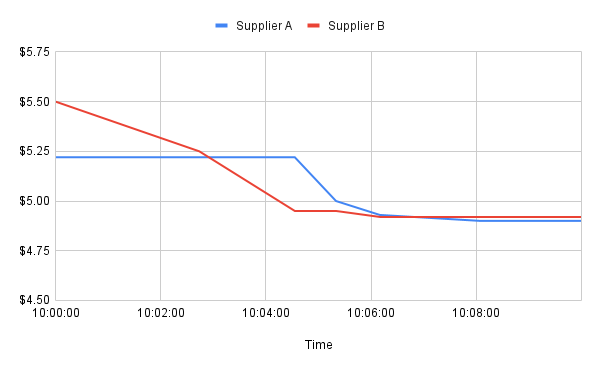
This very reasonable question almost always comes first when I mention e-Auctions. My first answer is usually that it’s like eBay backwards. An e-Auction, specifically here a reverse English auction, is an online negotiation tool where multiple suppliers bid to sell a specific good or service to a company by decreasing their prices, and the lowest price wins the business. For example, if a company wants to buy a widget, Supplier A bids $5.00 per widget and is in first place. Supplier B comes in and bids $4.95 per widget and takes first place, which moves Supplier A to second place. Supplier A can decide to lower their price and take first place back, or not. This continues until all suppliers have reached their best and final price.
An e-Auction is usually fairly quick, 10-20 minutes, but can last for hours if bidding is contentious or if there are many different bid lots within one auction. It also requires sourcing software with e-Auction capability, which many already have.
Among the procurement community, e-Auctions get a bad rap. They started in the mid 1990s at about the time eBay was on the rise, and suppliers tend to intensely dislike them. Why?
- By the time something reaches an e-Auction in negotiations, the negotiation is down to only price and suppliers do not have a chance to argue their non-monetary value proposition (quality, delivery time, extra services, etc.)
- An e-Auction can feel cold, even lonely, in a world that is about relationships
- Software systems can be tricky and non-intuitive and frustrating
- Internal customers want to just award the business to the incumbent supplier and not have to go through the competition process
- An e-Auction adds time to the process.
So why do a reverse auction at all if it’s so terrible, impersonal and time-consuming? The simple answer is twofold: because it adds value and because most of these objections simply aren’t true. An e-Auction program reduces costs by an average of 2-3% beyond the lowest Request for Proposal (RFP) price for every bit of spend put through it. This is despite the fact that about half of all auctions have no cost reduction at all. While the details are better suited for a separate article, e-Auctions do not have to neglect relationships, ignore quality and supplier value, upset internal customers, or add time.
An e-Auction program implemented with strong change management practices and buy-in can gain value with:
- Clearer scopes of work
- Better supplier transparency
- A shorter time to bid/negotiate
Future articles will address these in more depth, or feel free to contact me to have a conversation.

